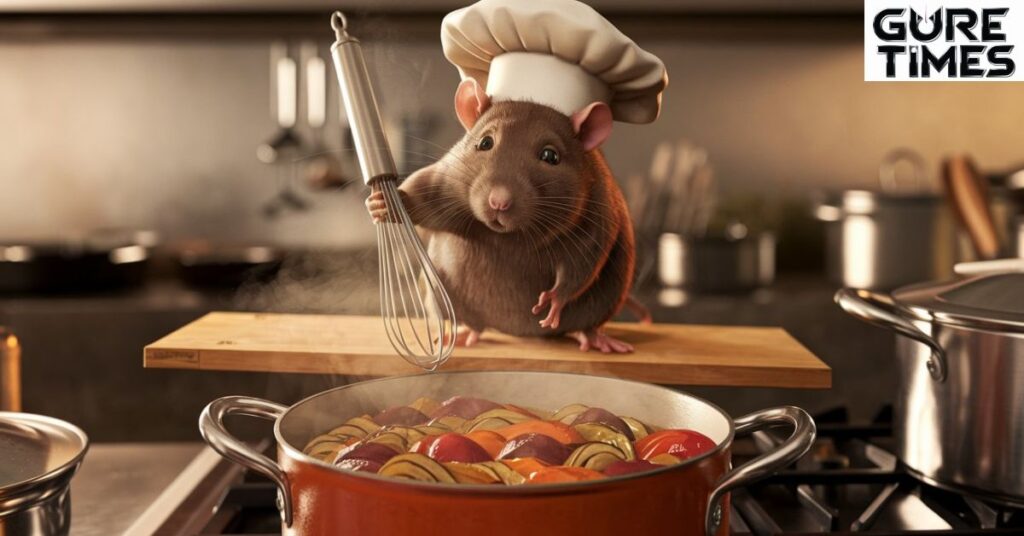Ratatouille, a quintessential French vegetable dish, offers a delightful taste of Provençal cuisine. This vegetable stew is celebrated for its rich flavors, vibrant colors, and healthy ingredients. In this comprehensive guide, we delve into the origins of ratatouille, its preparation, and its cultural significance. Whether you’re a culinary enthusiast or a casual cook, you’ll find everything you need to know about this classic French cooking masterpiece.
The Origins of Ratatouille
Ratatouille hails from Provence, where its simple yet flavorful blend of vegetables mirrors the region’s rich agricultural heritage. This beloved French vegetable dish has evolved from a humble stew into a culinary icon celebrated for its seasonal freshness and versatility.
Historical Background
Ratatouille originates from the sun-drenched region of Provence in southern France. This dish, known for its simplicity and depth of flavor, reflects the region’s agricultural bounty. The term ratatouille comes from the Occitan word ratatolha, which means to stir up. Historically, it was a humble vegetable stew made from leftover vegetables and available produce.
Traditional Recipes and Regional Variations
The traditional ratatouille recipe features a mix of seasonal vegetables like tomatoes, eggplant, zucchini, bell peppers, and onions. Each ingredient is sautéed and then simmered together with herbs to create a harmonious blend of flavors. Over time, several regional variations have emerged, including:
- Tian Provençal: A baked version with vegetables arranged in overlapping layers.
- Confit Byaldi: A refined take on ratatouille popularized by Chef Thomas Keller, featuring a more elegant presentation.
A Traditional French Classic

Ratatouille stands as a celebrated symbol of French cuisine, reflecting the rich culinary traditions of Provence. This iconic dish marries fresh, high-quality ingredients with a straightforward preparation, embodying the essence of classic French cooking.
Definition and Characteristics
Ratatouille is a hallmark of French cuisine. This classic French vegetable dish showcases the essence of Provençal cooking through its use of fresh, high-quality ingredients and straightforward preparation. The dish is known for its ability to highlight the natural flavors of vegetables, making it a staple in many French households.
Key Elements That Define Its Authenticity
To achieve an authentic ratatouille, consider these essential elements:
- Seasonal Vegetables: Opt for the freshest produce available to ensure the best flavor.
- Herbs de Provence: A blend of dried herbs such as thyme, basil, and rosemary, crucial for the dish’s aromatic quality.
- Tomato-Based Sauce: The sauce forms the foundation of the dish, enhancing its flavor and texture.
| Aspect | Details |
|---|---|
| Dish Name | Ratatouille |
| Origin | Provence, France |
| Main Ingredients | Eggplant, zucchini, bell peppers, tomatoes, onions |
| Key Herbs | Herbs de Provence (thyme, basil, rosemary) |
| Cooking Temperature | 375°F (190°C) |
| Cooking Time | 45 minutes to 1 hour |
| Serving Suggestions | Grilled chicken, pan-seared fish, lentils, crusty bread |
| Wine Pairings | Rosé, Pinot Noir |
| Nutritional Information | ~100-150 calories per serving, low in saturated fat |
| Storage Time | Refrigerate: Up to 4 days; Freeze: Up to 3 months |
| Preparation Techniques | Sautéing, layering, baking |
Evolution Over Time
Ratatouille, with its roots deeply embedded in rustic Provençal cooking, has undergone a remarkable evolution. This beloved French vegetable dish has not only retained its traditional charm but has also embraced modern culinary trends and techniques, making it a versatile and contemporary favorite.
How the Dish Has Evolved
From its rustic beginnings, ratatouille has evolved into a symbol of culinary arts. The dish has adapted to contemporary tastes and cooking styles while maintaining its core essence. Modern chefs have experimented with various cooking techniques and presentation methods, transforming ratatouille into a versatile dish suitable for various occasions.
Modern Adaptations and Variations
Today, ratatouille can be found in many forms beyond the traditional stew:
- Ratatouille Pasta: Incorporates the vegetable stew into pasta dishes for added richness.
- Ratatouille Pizza: Uses ratatouille as a topping, combining Mediterranean flavors with a crispy crust.
- Ratatouille Soup: Transforms the stew into a flavorful soup, perfect for a comforting meal.
Cultural Significance
Ratatouille is not just a dish but a cultural icon that encapsulates the essence of French cooking. It embodies the principles of seasonal, local eating and has made a significant impact both in France and globally.
Ratatouille’s Role in French Culture
Ratatouille is more than just a dish; it embodies the principles of French cooking. The dish reflects the values of seasonal eating and local sourcing, which are central to French culinary traditions. In France, ratatouille is a beloved comfort food often enjoyed during the summer months when vegetables are at their peak.
Representation in Global Culinary Contexts
The global popularity of ratatouille received a significant boost from the Pixar film “Ratatouille.” The film’s portrayal of the dish as a symbol of creativity and passion in cooking introduced it to a wider audience. The movie helped elevate ratatouille from a simple stew to a celebrated dish recognized worldwide.
Read More: Billy Carson Net Worth, Age, Height, Weight, Personal Life
Ingredients for Perfection
Creating the perfect ratatouille hinges on selecting the right ingredients and balancing flavors. Each component plays a crucial role in achieving the dish’s distinctive taste and texture.
The Vegetable Medley
The heart of any ratatouille recipe is the selection of ratatouille ingredients. The dish typically features:
- Eggplant: Provides a creamy texture and absorbs flavors well.
- Zucchini: Adds a tender bite and complements other vegetables.
- Bell Peppers: Contributes sweetness and color.
- Tomatoes: Forms the base of the tomato sauce, enriching the dish with depth.
- Onions and Garlic: Enhance the overall aroma and flavor.
Herbs and Seasonings
For an authentic taste, use Herbs de Provence, which usually includes:
- Thyme: Offers an earthy, slightly sweet flavor.
- Basil: Adds a fresh, aromatic quality.
- Rosemary: Infuses a piney, robust taste.
Other seasonings to consider include:
- Salt and Pepper: Essential for balancing the flavors.
- Olive Oil: Adds richness and depth to the dish.
Optional Additions
Customize your ratatouille with optional ingredients:
- Cheese: Grated Parmesan or crumbled feta can add extra flavor.
- Olives: Introduce a briny contrast.
- Nuts: Pine nuts or almonds can provide added texture.
Preparing the Vegetables

Preparing the vegetables for ratatouille is crucial for both flavor and presentation. Proper slicing, strategic layering, and thoughtful prepping ensure a delicious and visually appealing dish.
Slicing Techniques
Proper slicing ensures even cooking and a pleasing presentation. Use the following techniques:
- Eggplant: Cut into uniform cubes or rounds.
- Zucchini: Slice into half-moons or rounds.
- Bell Peppers: Dice into bite-sized pieces.
- Tomatoes: Chop into small chunks.
Layering for Aesthetics
Vegetable layering enhances the dish’s visual appeal. Techniques include:
- Tian Style: Arrange vegetables in concentric circles for an elegant presentation.
- Rustic Layering: Pile vegetables in a casual, mixed style for a more homey look.
Prepping Tips
- Pre-Salt Eggplant: To reduce bitterness, salt and drain before cooking.
- Blanch Tomatoes: To easily remove skins, blanch them briefly in boiling water.
The Perfect Sauce Base
The tomato sauce is the backbone of a flavorful ratatouille, bringing together all the vegetables with its rich, aromatic base. Creating a perfect sauce requires careful attention to the blend of ingredients and cooking techniques to elevate the dish’s taste and texture.
Tomato Sauce Foundation
A rich tomato-based sauce is essential for ratatouille. Key ingredients include:
- Tomatoes: Fresh or canned, blended into a smooth puree.
- Onions and Garlic: Sautéed to build a flavorful base.
- Olive Oil: Adds richness and depth.
Adding Depth of Flavor
Enhance the sauce with these techniques:
- Simmering Longer: Concentrates flavors and improves depth.
- Adding Wine: A splash of red or white wine can elevate the sauce.
- Incorporating Herbs: Add extra fresh herbs during simmering for additional flavor.
Consistency Matters
Achieve the right sauce consistency by:
- Simmering: To reduce and thicken the sauce.
- Blending: For a smoother texture if desired.
Assembly and Baking
Assembling and baking ratatouille is the final step that brings all the vibrant flavors and textures together. Proper layering and baking techniques ensure that each vegetable is perfectly cooked and infused with the rich, aromatic tomato sauce.
Layering the Vegetables
Vegetable layering is crucial for even cooking and presentation. Follow these steps:
- Bottom Layer: Start with a layer of sauce in the baking dish.
- Vegetable Layers: Alternate layers of vegetables, ensuring even distribution.
- Top Layer: Finish with a final layer of vegetables and sauce.
Cover and Bake
- Cover the Dish: To prevent drying out during baking.
- Bake at 375°F (190°C): For about 45 minutes to 1 hour, or until vegetables are tender.
Finishing Touches
- Garnish with Fresh Herbs: Just before serving to add a burst of freshness.
- Drizzle with Olive Oil: For added richness and flavor.
Serving Suggestions
Elevate your ratatouille experience with thoughtful pairings and accompaniments. Whether you’re preparing a light dinner or a more substantial meal, these suggestions will help you create a memorable dining experience.
Pairing with Proteins
Ratatouille pairs well with various proteins:
- Grilled Chicken: Light and flavorful.
- Pan-Seared Fish: Adds a Mediterranean twist.
- Lentils: A hearty vegetarian option.
Wine Pairings
Complement ratatouille with these wines:
- Rosé: Light and refreshing, perfect for summer.
- Pinot Noir: Offers subtle fruitiness that pairs well with the dish’s flavors.
Making it a Meal
To create a complete meal:
- Serve with Crusty Bread: Ideal for soaking up the flavorful sauce.
- Add a Simple Salad: Balances the rich flavors of ratatouille.
Storing and Reheating Leftovers

To ensure your delicious ratatouille remains fresh and flavorful, proper storage and reheating techniques are essential. Here’s how to keep your dish at its best, whether you’re enjoying it right away or saving it for later.
Proper Storage
Store leftovers in airtight containers to keep them fresh. Refrigerate for up to 4 days.
Reheating Tips
- Microwave: Reheat in short intervals, stirring occasionally.
- Oven: Bake at 350°F (175°C) until heated through.
Freezing for Later
- Cool Completely: Before freezing to prevent ice crystals.
- Use Freezer-Safe Containers: Store for up to 3 months.
Health Benefits of Ratatouille
Ratatouille isn’t just a delicious French vegetable dish; it’s also packed with nutritional benefits. From its rich blend of vitamins and antioxidants to its low calorie and heart-healthy properties, this vegetable stew offers a host of health advantages.
Nutrient-Rich Ingredients
Ratatouille is packed with nutrients:
- Vitamins: From vegetables like bell peppers and tomatoes.
- Antioxidants: Found in herbs and fresh produce.
Low in Calories
- Caloric Content: Approximately 100-150 calories per serving.
- Healthy Fats: From olive oil, which is heart-healthy.
Heart-Healthy
- Rich in Fiber: Supports cardiovascular health.
- Low in Saturated Fat: Making it a great option for heart health.
Tips for Perfecting Your Ratatouille
Elevate your ratatouille with these expert tips and tricks. From experimenting with spices to trying new herbs, discover how to make this classic French vegetable dish even more delicious.
Experiment with Flavors
- Add Spice: Consider a pinch of red pepper flakes for a bit of heat.
- Try Different Herbs: Use oregano
FAQ’S
What is ratatouille?
Ratatouille is a traditional French vegetable dish made from a mix of sautéed vegetables, typically including tomatoes, eggplant, zucchini, and bell peppers. It’s known for its rich flavor and vibrant colors.
Where did ratatouille originate?
Ratatouille hails from Provence, France. It’s a classic Provençal dish that reflects the region’s love for fresh, seasonal vegetables.
How do you prepare ratatouille?
To prepare ratatouille, chop the vegetables and sauté them with herbs and a tomato-based sauce. Layer the vegetables in a baking dish and cook until tender.
Can ratatouille be made ahead of time?
Yes, ratatouille can be prepared in advance and stored in the refrigerator for up to 4 days. It can also be frozen for up to 3 months.
What are some good side dishes to serve with ratatouille?
Ratatouille pairs well with crusty bread, grilled chicken, or a fresh salad. It also complements grains like rice or quinoa for a hearty meal.
Conclusion
Ratatouille is more than just a vegetable stew; it’s a celebration of fresh, seasonal produce and classic French cooking. This dish beautifully combines simplicity and flavor, making it a favorite in homes around the world.
Whether you’re enjoying it as a comforting meal or serving it at a dinner party, ratatouille offers a taste of Provençal charm and culinary tradition. So, gather your ratatouille ingredients, follow the preparation tips, and savor the delicious journey of this timeless recipe.











